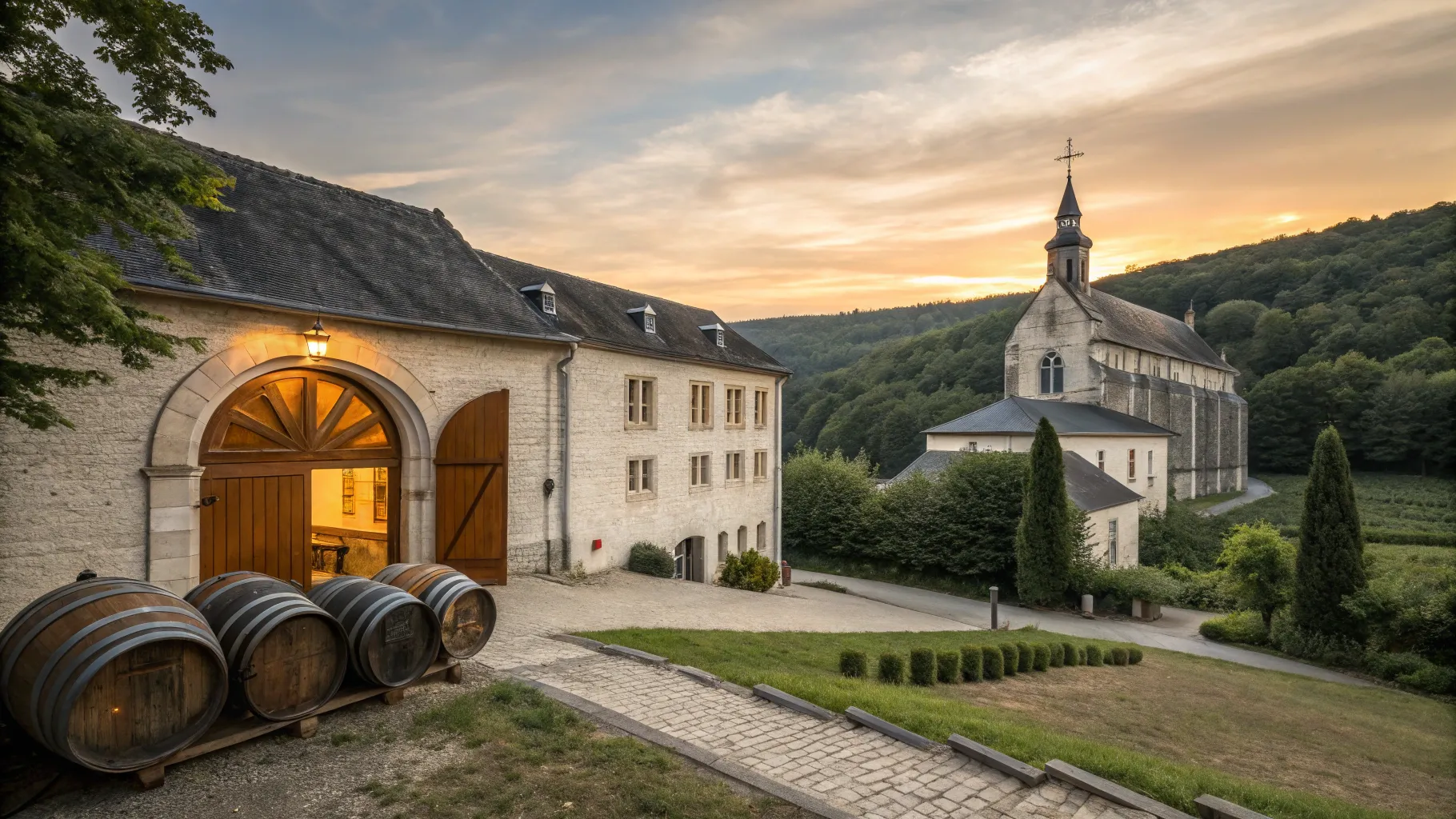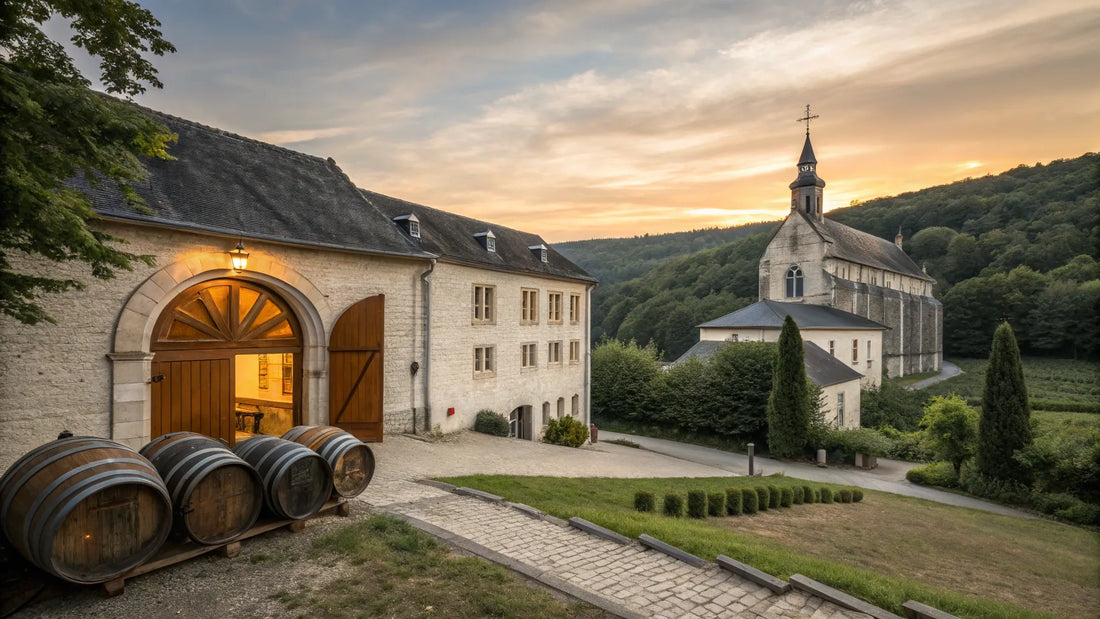A Journey through the History of Rochefort: The Trappist Brewery

Welcome to our journey of discovery into the fascinating world of Trappist beer, with Rochefort as our first stop. This brewery, with a rich history and some of the best beers in the world, offers us a glimpse into the unique combination of religion, tradition, and craftsmanship that characterizes these beers.
Introduction to Trappist Beer 🍻
Trappist beer, a term that makes the hearts of beer lovers beat faster, is more than just a drink; it is a symbol of tradition and spirituality. Made within the walls of Trappist monasteries, each glass reflects the monks' dedication to their craft. These beers are not only brewed for sale but also to support their lifestyle and charitable causes. Each Trappist beer has its own unique character, influenced by the ingredients, the brewing process, and the environment.
The most famous Trappist breweries are located in Belgium, where the rich brewing tradition has had a profound impact on beer culture worldwide. The monks are masters of their craft and use ancient techniques to create beers that are not only delicious but also tell a story. From the dark, powerful ales to the lighter, fruity varieties, Trappist beer offers something for everyone.
What makes Trappist beer unique?
- Authenticity: Only beers that meet strict criteria and are brewed within a Trappist monastery can carry the label 'Trappist beer'.
- Goal: The proceeds from the sale are often used for charity and to support the monastic community.
- Tradition: Every brewery has its own recipes and techniques that have been passed down from generation to generation.
The Innovation of the Monks 🧙♂️
The monks of Rochefort and other Trappist breweries are not only guardians of tradition but also pioneers of innovation. In a world where brewing techniques are rapidly evolving, they remain true to their artisanal methods while also being open to new ideas and techniques. This ensures that their beers not only stand the test of time but also occupy a unique place in the modern beer world.
An example of this innovation is the collaboration between different Trappist breweries. When a brewery encounters a challenge, such as quality issues or production problems, the monks are willing to share their knowledge and experience. This mutual support not only strengthens their community but also ensures that they stand stronger as a whole in the competitive beer market.
Progressive techniques
- Use of unique yeast strains: Monks experiment with different yeast strains to create unique flavors and aromas.
- Water analysis: The breweries conduct detailed analyses of their water sources to achieve the best brewing results.
- Modern equipment: Although they adhere to traditional methods, they sometimes integrate modern technologies to improve efficiency and quality.
The Role of Monks in the Brewery ⛪
The monks play a crucial role in the brewing process of Trappist beer. Their lives are dedicated to prayer, work, and community, and brewing beer is an integral part of this lifestyle. It is not only a way to finance their existence but also a way to express their faith. The brewing process is infused with spirituality, and each step is carried out with care and attention.
In the brewery, the monks are responsible for various tasks, from selecting ingredients to monitoring the brewing process. Their dedication and passion for the craft are palpable in every glass of beer they produce. This ensures that Trappist beer is not just a product, but a reflection of their way of life.
The daily routine of a monk-brewer
- Morning Prayer: The day begins with prayer, which helps the monks to maintain their focus and dedication.
- Brewing: The brewing process is often a joint effort, where all the monks contribute their skills and knowledge.
- Sales and distribution: After brewing, the monks are also involved in the sale of their beer, which brings them into contact with the outside world.
Rochefort: A Historical Perspective 🏰
Rochefort, located in the southeast of Belgium, has a rich and turbulent history that dates back to the 13th century. The monastery where the brewery is located is one of the oldest in the region. The origin of the brewery lies in a nunnery, but after the arrival of the monks in the 14th century, the brewery began to develop into what it is today.
Through the centuries, Rochefort has experienced many ups and downs, from war and destruction to reconstruction and flourishing. This history is not only a story of survival but also of adaptation and growth. The monks have repeatedly proven that they are capable of innovating and adapting to changing circumstances while remaining true to their traditions.
Important milestones in the history of Rochefort
- 13th century:
- 14th century: The arrival of the monks and the start of the brewery.
- 19th century: The brewery is officially established and begins commercial production.
The Turbulent History of Rochefort ⚔️
The history of Rochefort is anything but boring. The monastery has faced war, destruction, and even temporary closures. In the 17th century, the monastery was temporarily abandoned due to military actions, leading to a period of stagnation. It was not until the 19th century that brewing was restarted, but not without new challenges.
The impact of the two world wars was also felt. The brewery suffered significant damage, with loss of equipment and reduced production. Nevertheless, the monks maintained their determination and succeeded in rebuilding and innovating their brewery, which is a testament to their resilience and dedication to their craft.
Recovery and growth
- After the war: The monks restored the brewery and reintroduced their beers to the market.
- Modern times: Rochefort continues to innovate and develop new beers while staying true to their traditions.
- International recognition: The beers from Rochefort are now sought after worldwide, with a strong reputation for quality and flavor.
The Restart of the Brewery 🍺
After the tumultuous years, during which the brewery was closed and reopened, Rochefort found its way back to the brewing tradition. In 1899, after years of stagnation, the brewery was put back into use by the monks. This marked the beginning of a new chapter in the history of Rochefort.
The monks, determined to restore their craft, began brewing their characteristic beers. The focus was primarily on improving quality and expanding their product line. This was a time of renewed hope and creativity, where the monks combined their skills with the lessons they had learned from their sister breweries.
The role of collaboration
The collaboration with other Trappist breweries, such as Chimay, played a crucial role in the restart of Rochefort. By sharing knowledge and techniques, they were able to improve their brewing processes. This led to an increase in the quality of their beers, which was essential for their renewed success.
The monks of Rochefort learned not only about brewing techniques but also about the necessity of hygiene and quality control. These changes made a world of difference in their brewing process and ensured that their beers could be brought back to the market.
The Influence of Chimay on Rochefort 🌊
Chimay, as one of the most famous Trappist breweries, had a significant impact on Rochefort. The collaboration between both breweries led to improvements that helped Rochefort regain its position in the competitive beer market.
The monks of Chimay advised Rochefort on various aspects of the brewing process. This ranged from improving the equipment to obtaining its own yeast strain. Such innovations were essential for Rochefort to modernize its production and meet the rising demand for quality beers.
The development of unique beers
Thanks to the influence of Chimay, Rochefort was able to develop its own unique beers. The focus was on creating beers that not only reflected the rich tradition of the brewery but also aligned with the modern taste preferences of beer lovers. This led to the creation of various styles that have stood the test of time.
Rochefort's beers, with their complex flavors and aromatic profiles, are now a testament to the collaboration and perseverance of the monks. They have not only saved their own brewery but also contributed to the broader Trappist beer culture.
The Three Main Beers of Rochefort 🍷
Rochefort has three main products, each with its own unique character and flavor profile. These beers are a reflection of the history, tradition, and the dedication of the monks to their craft.
The three beers are Rochefort 6, Rochefort 8, and Rochefort 10. Each of these beers has its own specific characteristics, which together showcase the diversity of Rochefort's offerings. Let's take a closer look at them.
Rochefort 6: A Unique Beer Experience 🌟
Rochefort 6, with an alcohol percentage of 7.5%, is the lightest of the three. This beer has a sweet, yeast-driven flavor with notes of caramel and fruit. It is a perfect example of how Rochefort has improved the quality of their beers.
The flavor is rich and full, with a silky smooth mouthfeel. It has a complex balance between sweetness and a slight bitterness, making it a very drinkable beer. This makes Rochefort 6 ideal for both novice and experienced beer drinkers.
Rochefort 8: The Complexity of Flavor 🍂
Rochefort 8, with an alcohol percentage of 9.2%, offers a deeper and more complex experience than its little brother. This beer has a rich, dark color and a full aroma that contains hints of dried fruit, caramel, and a subtle blend of spices.
"The flavor is a harmony of sweetness and a slight bitterness, with an alcoholic warmth that enriches the drinking experience. Rochefort 8 is perfect to enjoy with a good meal or as an evening drink by the fireplace."
Rochefort 10: The Highlight of the Brewery 🍻
Rochefort 10 is the strongest beer from the brewery, with an alcohol content of 11.3%. This beer is a true masterpiece, with a complex flavor that develops over time. The aromas of dark fruits, chocolate, and caramel are prominently present, making it a very layered and satisfying beer.
The texture is full and creamy, with a long, warm aftertaste that invites more. Rochefort 10 is perfect for special occasions or to share with friends. This beer is not only a pleasure to drink, but also an experience to appreciate.
The Special Drinking Habits of the Monks 🍷
The monks of Rochefort have unique drinking habits that stem from their lifestyle and the traditions within the monastery. Brewing beer is for them not only a means of making a living but also a way to strengthen their community and experience their faith. They are not just brewers, but also advocates of a conscious way of life.
Unlike most people who enjoy a beer daily, the monks primarily drink their beers during special occasions. This makes their drinking experience unique and imbued with meaning. It is not uncommon for them to share their beers with guests or during religious celebrations.
The monks follow a strict routine, with an emphasis on prayer and work. This means that their drinking moments are carefully chosen, often after a long day of hard work in the brewery or the monastery. It makes their beers extra special, as they not only enjoy the flavors but also the community and the tradition that comes with it.
Rochefort 10: One of the Best Beers in the World 🌍
Rochefort 10 is not only one of the beers produced by the brewery, it is also one of the most acclaimed beers in the world. With an alcohol content of 11.3%, it is the strongest variant of Rochefort. This beer is a true masterpiece, reflecting the rich history and dedication of the monks.
The complex flavors of Rochefort 10 are a combination of dark fruits, chocolate, and caramel. These flavors have been carefully developed by the monks and are the result of a perfectly balanced brewing process. The texture is full and creamy, with a long, warm finish that invites you to have more. It is a beer that you must taste to truly appreciate the depth and complexity.
This beer not only has a strong reputation, but it is also a testament to the quality and care that the monks put into their brewery. Rochefort 10 is not only a pleasure to drink, but also an experience to share with friends or to enjoy during special occasions.
The New Triple from Rochefort 🍺
In 2020, Rochefort released its first new triple in more than sixty years. This new creation is a tribute to the rich brewing tradition, but with a modern twist. The monks have unearthed a recipe from the archives, originally developed in the 1920s, and have adapted it to contemporary tastes and preferences.
The triple is lighter than the other beers from Rochefort, with a playful mix of fruity and spicy notes. The brewing techniques are refined to ensure a fresh and accessible taste, making it a perfect beer for both new and experienced enthusiasts. The balance between sweetness and a light bitterness makes it an excellent choice for a wide audience.
With this new triple, Rochefort shows that they are not afraid to experiment and innovate while staying true to their heritage. This brew is a testament to the resilience and creativity of the monks, who are always looking for ways to improve and expand their craft.
The Future of Rochefort 🔮
The future of Rochefort looks promising. While the monks continue to dedicate themselves to their craft, they are also exploring new possibilities and developing new beers. The recent launch of the new triple shows that they are ready to adapt to the changing beer culture and consumer preferences.
The collaboration with other Trappist breweries remains an important aspect of their strategy. By sharing knowledge and experience, they can continue to improve their processes and produce high-quality beers. This mutual support not only strengthens their community but also ensures that the Trappist beer culture continues to grow and thrive.
"With their rich history and commitment to quality, Rochefort is well positioned to continue playing a leading role in the world of Trappist beer. The monks remain true to their traditions while also being open to innovation and change. This makes Rochefort not only a brewery with a rich history but also one that is ready for the future."





